automatic transmission VOLVO S70 1999 Owners Manual
[x] Cancel search | Manufacturer: VOLVO, Model Year: 1999, Model line: S70, Model: VOLVO S70 1999Pages: 61, PDF Size: 0.88 MB
Page 9 of 61
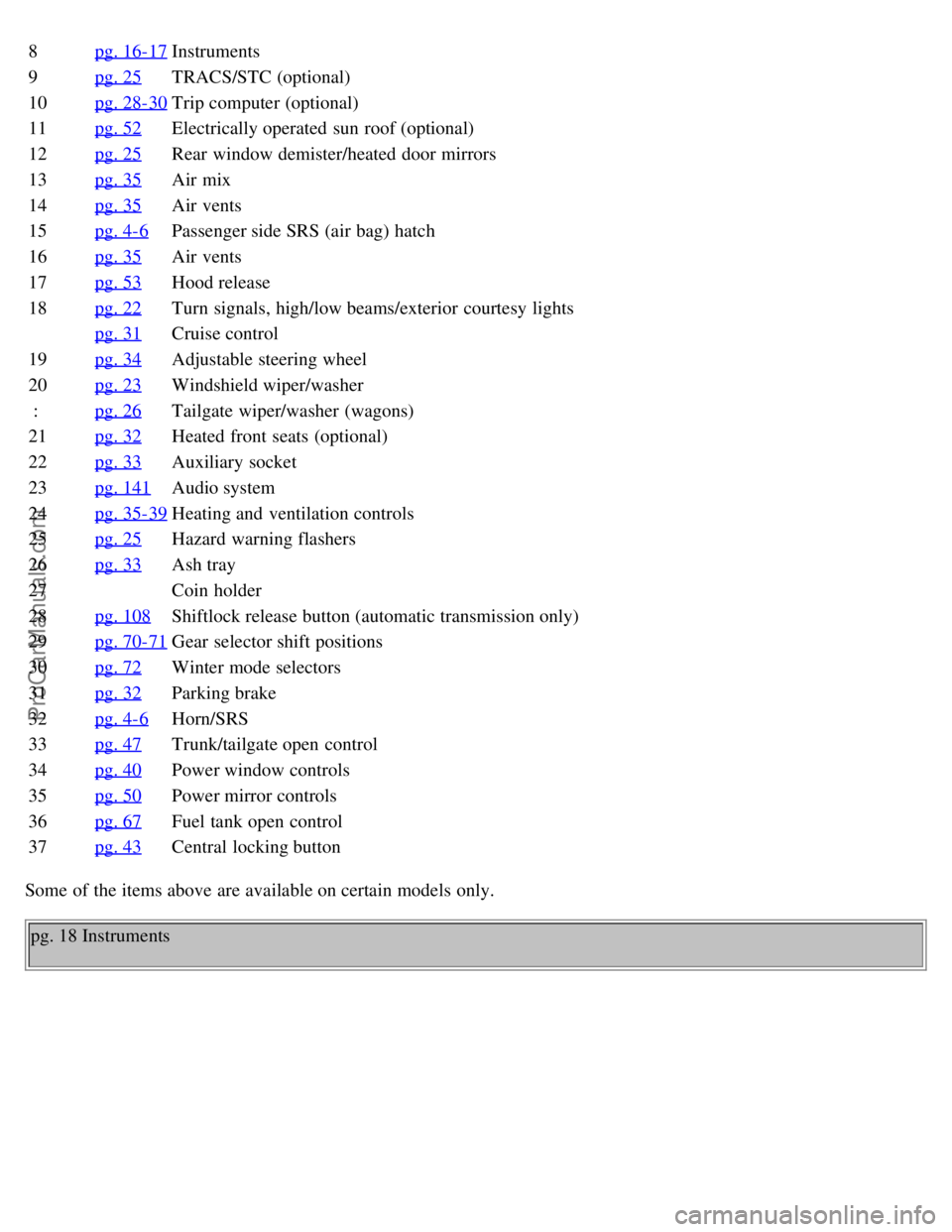
8pg. 16-17Instruments
9pg. 25TRACS/STC (optional)
10 pg. 28-30
Trip computer (optional)
11 pg. 52
Electrically operated sun roof (optional)
12 pg. 25
Rear window demister/heated door mirrors
13 pg. 35
Air mix
14 pg. 35
Air vents
15 pg. 4-6
Passenger side SRS (air bag) hatch
16 pg. 35
Air vents
17 pg. 53
Hood release
18 pg. 22
Turn signals, high/low beams/exterior courtesy lights
pg. 31
Cruise control
19 pg. 34
Adjustable steering wheel
20 pg. 23
Windshield wiper/washer
: pg. 26
Tailgate wiper/washer (wagons)
21 pg. 32
Heated front seats (optional)
22 pg. 33
Auxiliary socket
23 pg. 141
Audio system
24 pg. 35-39
Heating and ventilation controls
25 pg. 25
Hazard warning flashers
26 pg. 33
Ash tray
27 Coin holder
28 pg. 108
Shiftlock release button (automatic transmission only)
29 pg. 70-71
Gear selector shift positions
30 pg. 72
Winter mode selectors
31 pg. 32
Parking brake
32 pg. 4-6
Horn/SRS
33 pg. 47
Trunk/tailgate open control
34 pg. 40
Power window controls
35 pg. 50
Power mirror controls
36 pg. 67
Fuel tank open control
37 pg. 43
Central locking button
Some of the items above are available on certain models only.
pg. 18 Instruments
ProCarManuals.com
Page 17 of 61
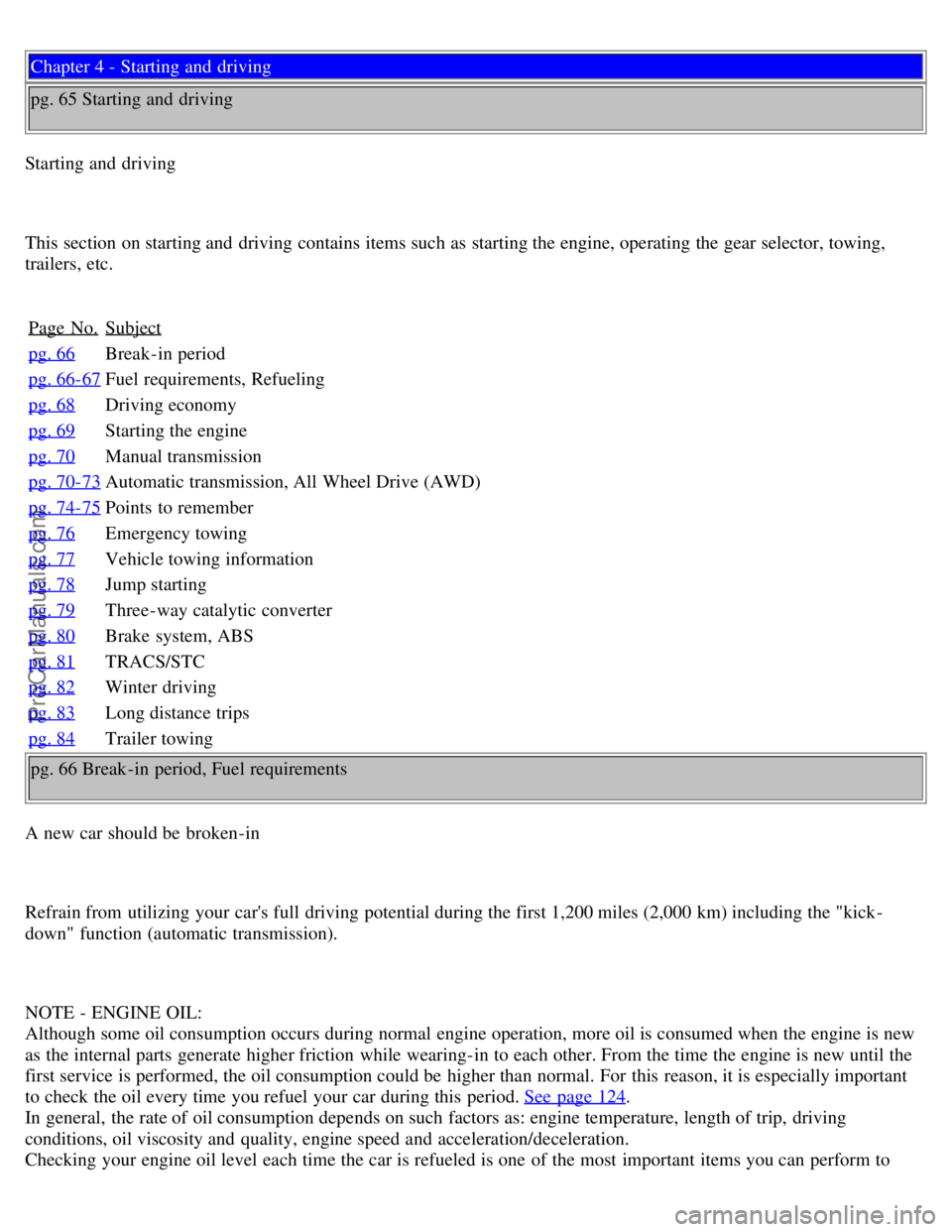
Chapter 4 - Starting and driving
pg. 65 Starting and driving
Starting and driving
This section on starting and driving contains items such as starting the engine, operating the gear selector, towing,
trailers, etc. Page No.
Subject
pg. 66Break-in period
pg. 66-67
Fuel requirements, Refueling
pg. 68
Driving economy
pg. 69
Starting the engine
pg. 70
Manual transmission
pg. 70-73
Automatic transmission, All Wheel Drive (AWD)
pg. 74-75
Points to remember
pg. 76
Emergency towing
pg. 77
Vehicle towing information
pg. 78
Jump starting
pg. 79
Three-way catalytic converter
pg. 80
Brake system, ABS
pg. 81
TRACS/STC
pg. 82
Winter driving
pg. 83
Long distance trips
pg. 84
Trailer towing
pg. 66 Break-in period, Fuel requirements
A new car should be broken-in
Refrain from utilizing your car's full driving potential during the first 1,200 miles (2,000 km) including the "kick -
down" function (automatic transmission).
NOTE - ENGINE OIL:
Although some oil consumption occurs during normal engine operation, more oil is consumed when the engine is new
as the internal parts generate higher friction while wearing-in to each other. From the time the engine is new until the
first service is performed, the oil consumption could be higher than normal. For this reason, it is especially important
to check the oil every time you refuel your car during this period. See page 124
.
In general, the rate of oil consumption depends on such factors as: engine temperature, length of trip, driving
conditions, oil viscosity and quality, engine speed and acceleration/deceleration.
Checking your engine oil level each time the car is refueled is one of the most important items you can perform to
ProCarManuals.com
Page 20 of 61
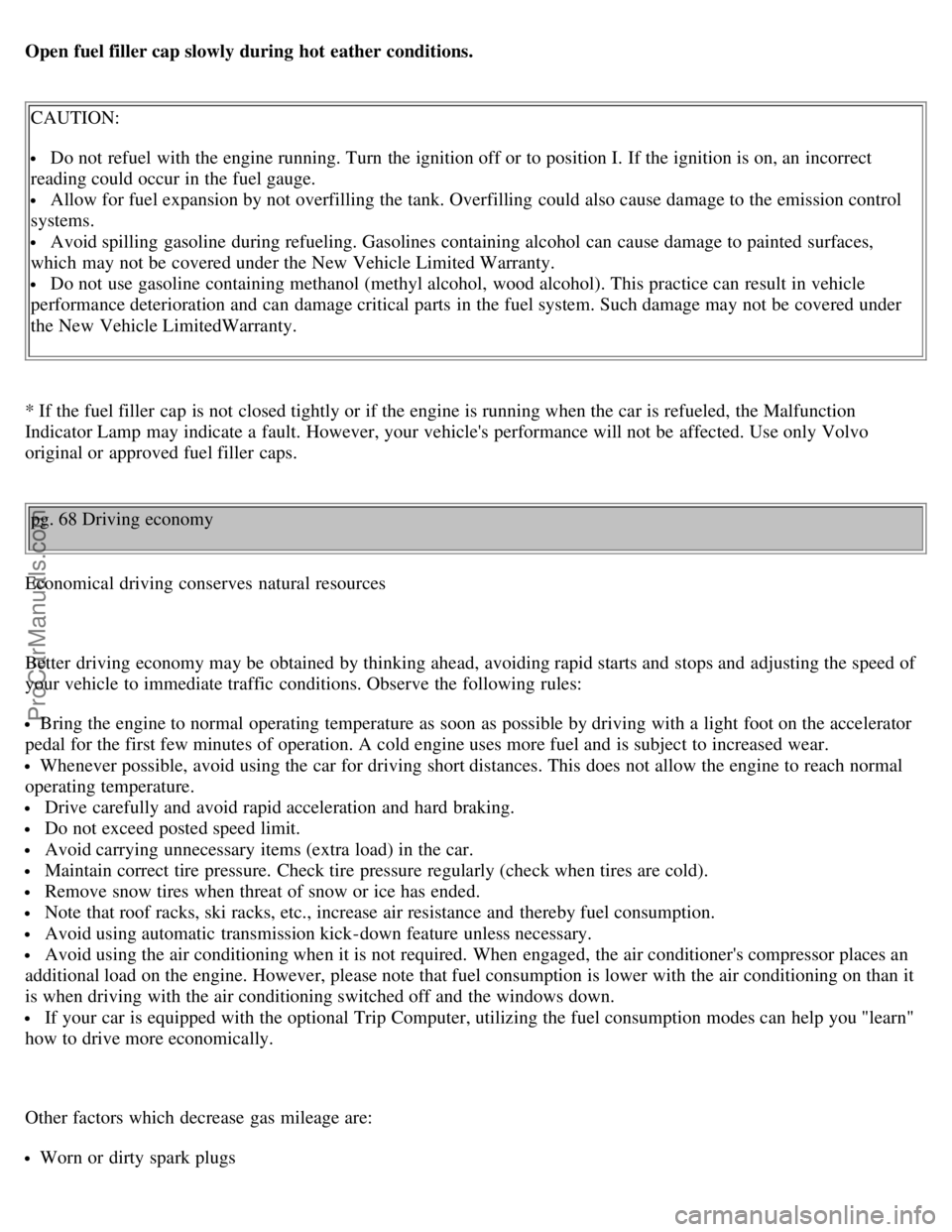
Open fuel filler cap slowly during hot eather conditions.
CAUTION:
Do not refuel with the engine running. Turn the ignition off or to position I. If the ignition is on, an incorrect
reading could occur in the fuel gauge.
Allow for fuel expansion by not overfilling the tank. Overfilling could also cause damage to the emission control
systems.
Avoid spilling gasoline during refueling. Gasolines containing alcohol can cause damage to painted surfaces,
which may not be covered under the New Vehicle Limited Warranty.
Do not use gasoline containing methanol (methyl alcohol, wood alcohol). This practice can result in vehicle
performance deterioration and can damage critical parts in the fuel system. Such damage may not be covered under
the New Vehicle LimitedWarranty.
* If the fuel filler cap is not closed tightly or if the engine is running when the car is refueled, the Malfunction
Indicator Lamp may indicate a fault. However, your vehicle's performance will not be affected. Use only Volvo
original or approved fuel filler caps. pg. 68 Driving economy
Economical driving conserves natural resources
Better driving economy may be obtained by thinking ahead, avoiding rapid starts and stops and adjusting the speed of
your vehicle to immediate traffic conditions. Observe the following rules:
Bring the engine to normal operating temperature as soon as possible by driving with a light foot on the accelerator
pedal for the first few minutes of operation. A cold engine uses more fuel and is subject to increased wear.
Whenever possible, avoid using the car for driving short distances. This does not allow the engine to reach normal
operating temperature.
Drive carefully and avoid rapid acceleration and hard braking.
Do not exceed posted speed limit.
Avoid carrying unnecessary items (extra load) in the car.
Maintain correct tire pressure. Check tire pressure regularly (check when tires are cold).
Remove snow tires when threat of snow or ice has ended.
Note that roof racks, ski racks, etc., increase air resistance and thereby fuel consumption.
Avoid using automatic transmission kick-down feature unless necessary.
Avoid using the air conditioning when it is not required. When engaged, the air conditioner's compressor places an
additional load on the engine. However, please note that fuel consumption is lower with the air conditioning on than it
is when driving with the air conditioning switched off and the windows down.
If your car is equipped with the optional Trip Computer, utilizing the fuel consumption modes can help you "learn"
how to drive more economically.
Other factors which decrease gas mileage are:
Worn or dirty spark plugs
ProCarManuals.com
Page 28 of 61
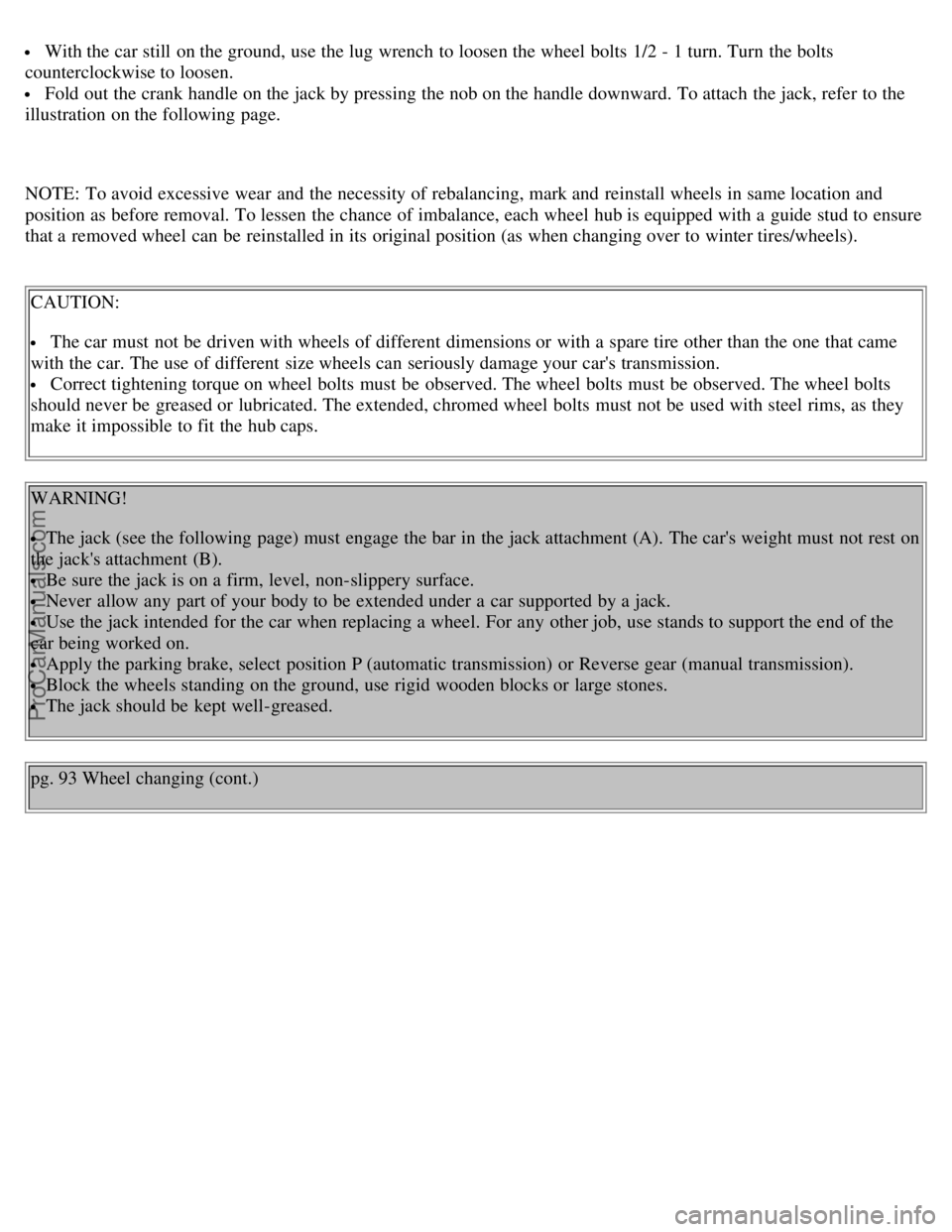
With the car still on the ground, use the lug wrench to loosen the wheel bolts 1/2 - 1 turn. Turn the bolts
counterclockwise to loosen.
Fold out the crank handle on the jack by pressing the nob on the handle downward. To attach the jack, refer to the
illustration on the following page.
NOTE: To avoid excessive wear and the necessity of rebalancing, mark and reinstall wheels in same location and
position as before removal. To lessen the chance of imbalance, each wheel hub is equipped with a guide stud to ensure
that a removed wheel can be reinstalled in its original position (as when changing over to winter tires/wheels).
CAUTION:
The car must not be driven with wheels of different dimensions or with a spare tire other than the one that came
with the car. The use of different size wheels can seriously damage your car's transmission.
Correct tightening torque on wheel bolts must be observed. The wheel bolts must be observed. The wheel bolts
should never be greased or lubricated. The extended, chromed wheel bolts must not be used with steel rims, as they
make it impossible to fit the hub caps.
WARNING!
The jack (see the following page) must engage the bar in the jack attachment (A). The car's weight must not rest on
the jack's attachment (B).
Be sure the jack is on a firm, level, non-slippery surface.
Never allow any part of your body to be extended under a car supported by a jack.
Use the jack intended for the car when replacing a wheel. For any other job, use stands to support the end of the
car being worked on.
Apply the parking brake, select position P (automatic transmission) or Reverse gear (manual transmission).
Block the wheels standing on the ground, use rigid wooden blocks or large stones.
The jack should be kept well-greased.
pg. 93 Wheel changing (cont.)
ProCarManuals.com
Page 38 of 61
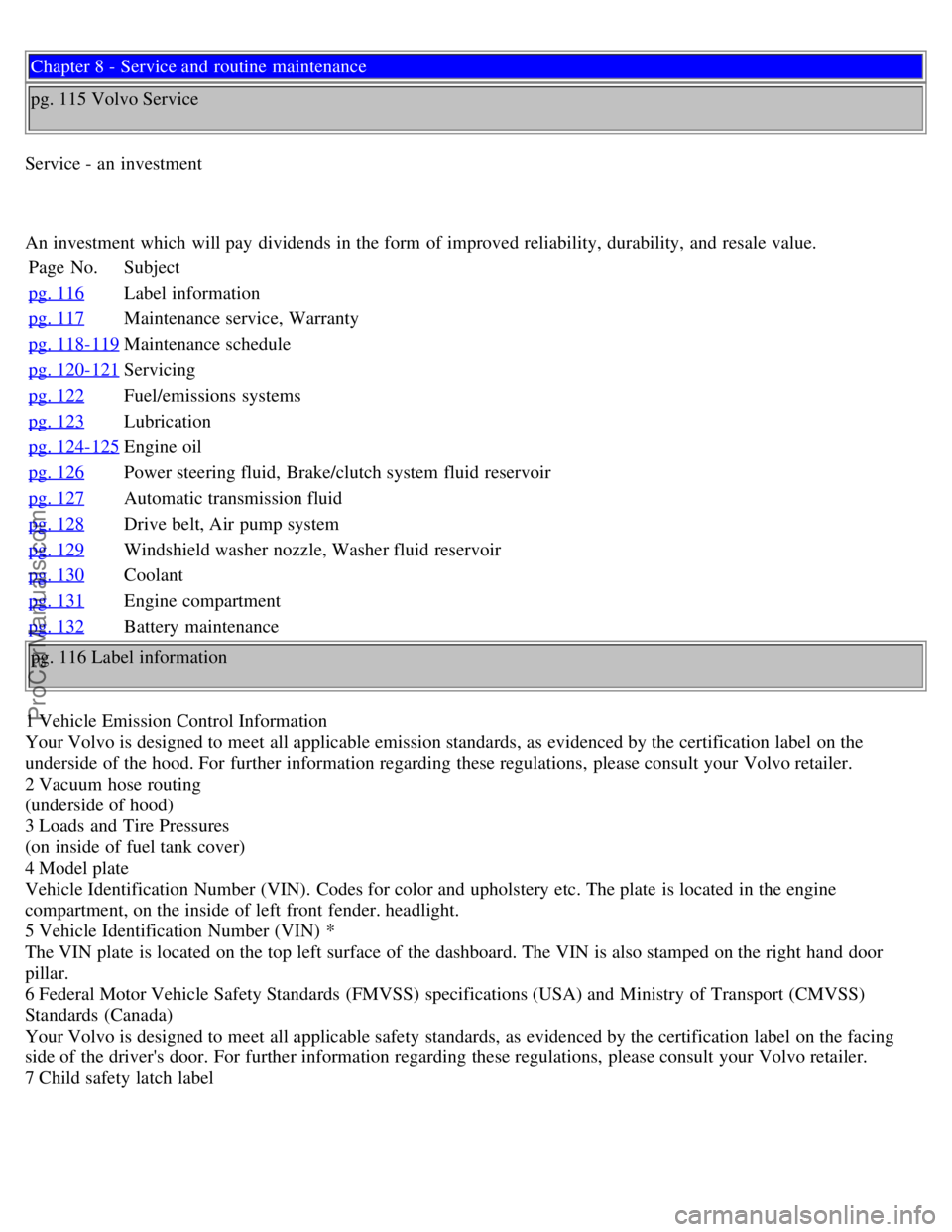
Chapter 8 - Service and routine maintenance
pg. 115 Volvo Service
Service - an investment
An investment which will pay dividends in the form of improved reliability, durability, and resale value. Page No. Subject
pg. 116
Label information
pg. 117
Maintenance service, Warranty
pg. 118-119
Maintenance schedule
pg. 120-121
Servicing
pg. 122
Fuel/emissions systems
pg. 123
Lubrication
pg. 124-125
Engine oil
pg. 126
Power steering fluid, Brake/clutch system fluid reservoir
pg. 127
Automatic transmission fluid
pg. 128
Drive belt, Air pump system
pg. 129
Windshield washer nozzle, Washer fluid reservoir
pg. 130
Coolant
pg. 131
Engine compartment
pg. 132
Battery maintenance
pg. 116 Label information
1 Vehicle Emission Control Information
Your Volvo is designed to meet all applicable emission standards, as evidenced by the certification label on the
underside of the hood. For further information regarding these regulations, please consult your Volvo retailer.
2 Vacuum hose routing
(underside of hood)
3 Loads and Tire Pressures
(on inside of fuel tank cover)
4 Model plate
Vehicle Identification Number (VIN). Codes for color and upholstery etc. The plate is located in the engine
compartment, on the inside of left front fender. headlight.
5 Vehicle Identification Number (VIN) *
The VIN plate is located on the top left surface of the dashboard. The VIN is also stamped on the right hand door
pillar.
6 Federal Motor Vehicle Safety Standards (FMVSS) specifications (USA) and Ministry of Transport (CMVSS)
Standards (Canada)
Your Volvo is designed to meet all applicable safety standards, as evidenced by the certification label on the facing
side of the driver's door. For further information regarding these regulations, please consult your Volvo retailer.
7 Child safety latch label
ProCarManuals.com
Page 40 of 61

Maintenance services
Your Volvo has passed several major inspections before being delivered to you, according to Volvo specifications. The
maintenance services outlined in this book should be performed as indicated. The extended maintenance service
intervals make it even more advisable to follow this program. Inspection and service should also be performed any
time a malfunction is observed or suspected. It is recommended that receipts for vehicle emission services be retained
in the event that questions arise concerning maintenance. See your "Maintenance Records Manual".
Applicable warranties - U.S.
In accordance with U.S. Federal Regulations, the following list of applicable U.S. warranties is provided. For Canadian
specification vehicles, see your separate warranty booklet.
New Car Limited Warranty
Parts and Accessories Limited Warranty
Corrosion Protection Limited Warranty
Seatbelt and Supplemental Restraint Systems Limited Warranty
Emission Design and Defect Warranty
Emission Performance Warranty
These are the Federal warranties; other warranties are provided as required by state law. Refer to your separate
Warranty booklet for detailed information concerning each of the warranties. pg. 118 Maintenance schedule
Maintenance schedule
Maintenance schedule
A = Adjust (Correct if necessary)
I = Inspect (Correct or Replace if necessary)
R = Replace
L = Lubricate
Maintenance Operation thousand miles
(thousand km) 7.5
(12)15
(24)22.5
(36) 30
(48)37.5
(60) 45
(72)52.5
(84) 60
(96)67.5
(108) 75
(120)82.5
(132)
90
2
(144)
EMISSION SYSTEM MAINTENANCE
Engine oil and filter
1R RR RR RR RR RRR
Engine drive belt (accessory belt) R
Air cleaner filter R R R
Spark plugs R R R
Automatic transmission fluid I I I I I I
ProCarManuals.com
Page 44 of 61
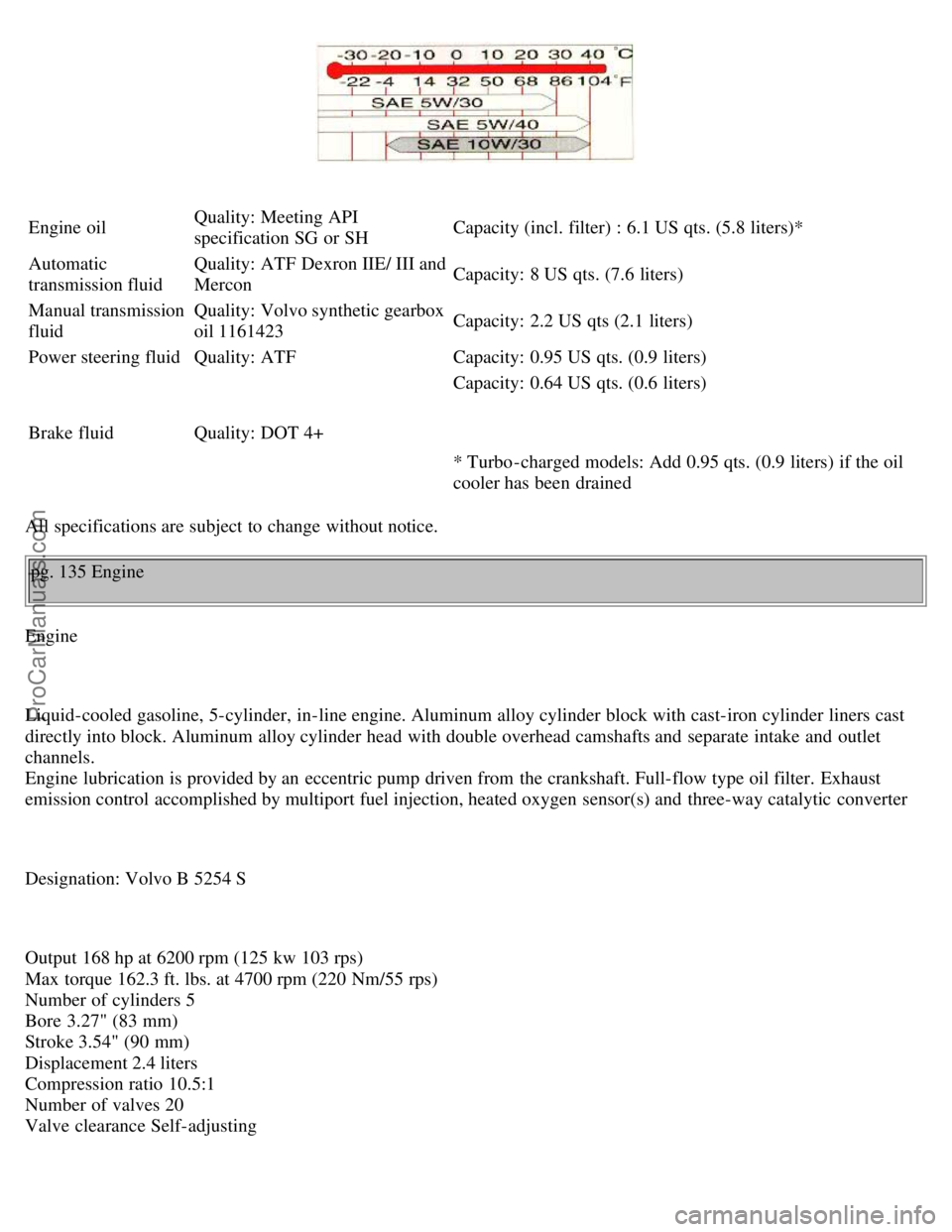
Engine oilQuality: Meeting API
specification SG or SH Capacity (incl. filter) : 6.1 US qts. (5.8 liters)*
Automatic
transmission fluid Quality: ATF Dexron IIE/ III and
Mercon
Capacity: 8 US qts. (7.6 liters)
Manual transmission
fluid Quality: Volvo synthetic gearbox
oil 1161423
Capacity: 2.2 US qts (2.1 liters)
Power steering fluid Quality: ATF Capacity: 0.95 US qts. (0.9 liters)
Brake fluid Quality: DOT 4+ Capacity: 0.64 US qts. (0.6 liters)
* Turbo -charged models: Add 0.95 qts. (0.9 liters) if the oil
cooler has been drained
All specifications are subject to change without notice.
pg. 135 Engine
Engine
Liquid-cooled gasoline, 5-cylinder, in-line engine. Aluminum alloy cylinder block with cast-iron cylinder liners cast
directly into block. Aluminum alloy cylinder head with double overhead camshafts and separate intake and outlet
channels.
Engine lubrication is provided by an eccentric pump driven from the crankshaft. Full-flow type oil filter. Exhaust
emission control accomplished by multiport fuel injection, heated oxygen sensor(s) and three-way catalytic converter
Designation: Volvo B 5254 S
Output 168 hp at 6200 rpm (125 kw 103 rps)
Max torque 162.3 ft. lbs. at 4700 rpm (220 Nm/55 rps)
Number of cylinders 5
Bore 3.27" (83 mm)
Stroke 3.54" (90 mm)
Displacement 2.4 liters
Compression ratio 10.5:1
Number of valves 20
Valve clearance Self-adjusting
ProCarManuals.com
Page 55 of 61
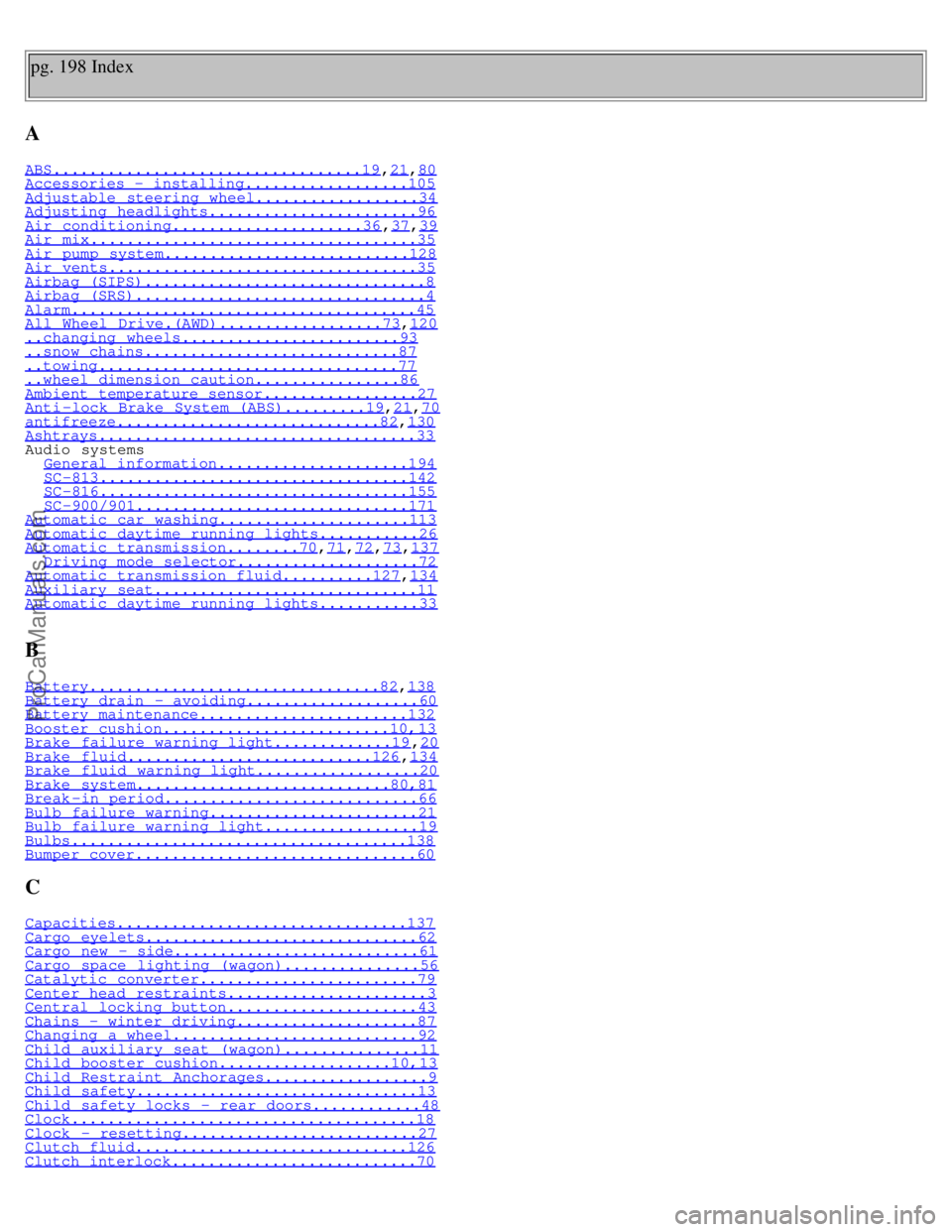
pg. 198 Index
A
ABS..................................19,21,80Accessories - installing..................105Adjustable steering wheel..................34Adjusting headlights.......................96Air conditioning.....................36,37,39Air mix....................................35Air pump system...........................128Air vents..................................35Airbag (SIPS)...............................8Airbag (SRS)................................4Alarm......................................45All Wheel Drive.(AWD)..................73,120..changing wheels........................93..snow chains............................87..towing.................................77..wheel dimension caution................86Ambient temperature sensor.................27Anti -lock Brake System (ABS).........19,21,70antifreeze.............................82,130Ashtrays...................................33Audio systems
General information.....................194
SC-813..................................142 SC-816..................................155 SC-900/901..............................171Automatic car washing.....................113Automatic daytime running lights...........26Automatic transmission........70,71,72,73,137 Driving mode selector....................72Automatic transmission fluid..........127,134Auxiliary seat.............................11Automatic daytime running lights...........33
B
Battery................................82,138Battery drain - avoiding...................60Battery maintenance.......................132Booster cushion.........................10,13Brake failure warning light.............19,20Brake fluid...........................126,134Brake fluid warning light..................20Brake system............................80,81Break -in period............................66Bulb failure warning.......................21Bulb failure warning light.................19Bulbs.....................................138Bumper cover...............................60
C
Capacities................................137Cargo eyelets..............................62Cargo new - side...........................61Cargo space lighting (wagon)...............56Catalytic converter........................79Center head restraints......................3Central locking button.....................43Chains - winter driving....................87Changing a wheel...........................92Child auxiliary seat (wagon)...............11Child booster cushion...................10,13Child Restraint Anchorages..................9Child safety...............................13Child safety locks - rear doors............48Clock......................................18Clock - resetting..........................27Clutch fluid..............................126Clutch interlock...........................70
ProCarManuals.com